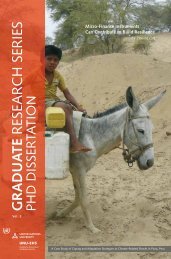Unveiling Women as Pillars of Peace Peace Building in ...
Unveiling Women as Pillars of Peace Peace Building in ...
Unveiling Women as Pillars of Peace Peace Building in ...
Create successful ePaper yourself
Turn your PDF publications into a flip-book with our unique Google optimized e-Paper software.
Given this history, the ethnic cl<strong>as</strong>hes that erupted on the eve <strong>of</strong> Christm<strong>as</strong> <strong>in</strong> 1991 were not<br />
entirely a surprise to communities <strong>of</strong> Western Kenya. They did not anticipate the dynamics and<br />
character <strong>of</strong> the prolonged violence. L<strong>as</strong>t<strong>in</strong>g for nearly two years, the <strong>in</strong>tensity <strong>of</strong> brutality<br />
<strong>in</strong>volved, the scale and scope <strong>of</strong> are<strong>as</strong> affected, and their negative impacts on peoples’ livelihoods<br />
were largely unforeseen. Tak<strong>in</strong>g place aga<strong>in</strong>st the backdrop <strong>of</strong> <strong>in</strong>cre<strong>as</strong><strong>in</strong>g pressure to democratise,<br />
these cl<strong>as</strong>hes were unlike any other before them. Groups were propelled pr<strong>in</strong>cipally by the<br />
ideology <strong>of</strong> ethnic cleans<strong>in</strong>g. Gross violations <strong>of</strong> human rights marked the cl<strong>as</strong>hes, with m<strong>as</strong>sive<br />
destruction <strong>of</strong> property and deaths <strong>of</strong> people and valuable livestock. In addition, the cl<strong>as</strong>hes led<br />
the displacement <strong>of</strong> nearly 5 percent <strong>of</strong> the total population <strong>of</strong> the then Bungoma District. 5<br />
For the first time <strong>in</strong> the history <strong>of</strong> tensions and conflicts <strong>in</strong> this region, the people saw<br />
government security forces <strong>as</strong> partisan. They accused them <strong>of</strong> accentuat<strong>in</strong>g rather than halt<strong>in</strong>g<br />
conflicts. In the words <strong>of</strong> one <strong>in</strong>terviewee:<br />
Chiefs began to behave like KANU youth w<strong>in</strong>gers. Political leaders<br />
began to brand people with names. At that time, Elgon w<strong>as</strong> divided<br />
<strong>in</strong>to only two groups, KANU and Mwakenya. 6 If you were Sabaot,<br />
you were KANU. Everybody else w<strong>as</strong> Mwakenya and had to go.<br />
Leaders <strong>of</strong> Mt. Elgon declared their region a KANU zone, <strong>in</strong> l<strong>in</strong>e with the declaration <strong>of</strong> the entire<br />
Rift Valley. In early December 1991, preparations for cl<strong>as</strong>hes were set <strong>in</strong> motion by the actions <strong>of</strong><br />
a District Officer who ordered the arrest <strong>of</strong> a woman accused <strong>of</strong> feed<strong>in</strong>g violent youths. The arrest,<br />
carried out <strong>in</strong> the early morn<strong>in</strong>g, angered Sabaots who <strong>in</strong>terpreted it <strong>as</strong> special humiliation by<br />
government <strong>of</strong>ficers seen <strong>as</strong> “collud<strong>in</strong>g” with their enemies.<br />
By the beg<strong>in</strong>n<strong>in</strong>g <strong>of</strong> 1993, the trust that had governed peaceful coexistence among the<br />
communities <strong>of</strong> Bungoma w<strong>as</strong> completely shattered. On the one hand, Mt. Elgon and its Sabaot<br />
population felt their very existence threatened by the hostile Luyha communities who had them<br />
closed <strong>in</strong> on the E<strong>as</strong>t and the South. On the other hand, all “foreigners” had their property<br />
destroyed or confiscated before be<strong>in</strong>g expelled from Mt. Elgon. The creation <strong>of</strong> ethnic exclusion<br />
zones w<strong>as</strong> a fait accompli, and the breakdown <strong>in</strong> peaceful coexistence came with it.<br />
Responses to the Ethnic Cl<strong>as</strong>hes and Initial Challenges<br />
The people were unprepared for the eruption <strong>of</strong> violence because they failed to<br />
acknowledge the early warn<strong>in</strong>g signs. These <strong>in</strong>cluded tension generated by the Katakwa issue and<br />
the manipulation <strong>of</strong> ongo<strong>in</strong>g political changes. People flee<strong>in</strong>g destruction and persecution <strong>in</strong> their<br />
homes sought sanctuary <strong>in</strong> local churches and markets. The Catholic Church and the National<br />
Council <strong>of</strong> Churches <strong>of</strong> Kenya (NCCK) were among the first to <strong>in</strong>itiate <strong>as</strong>sistance programmes<br />
through their established networks and <strong>in</strong>stitutions. Church build<strong>in</strong>gs, schools, and some<br />
parishioners gave shelter to those flee<strong>in</strong>g the hostilities. Hospitals and dispensaries <strong>in</strong>itially<br />
provided free medical services. Perceiv<strong>in</strong>g displacement <strong>as</strong> temporary, provisional and shortterm<br />
<strong>as</strong>sistance focussed primarily on reliev<strong>in</strong>g material needs. Relief providers hoped that<br />
violence would end so people could return to their homes with<strong>in</strong> a short period. As conflict<br />
became more protracted, the capacity <strong>of</strong> local structures w<strong>as</strong> overwhelmed. In the words <strong>of</strong> Tecla<br />
Wanjala, a pillar <strong>of</strong> peace <strong>in</strong> this monograph who w<strong>as</strong> then the Development Co-ord<strong>in</strong>ator with the<br />
Catholic Church:<br />
36



